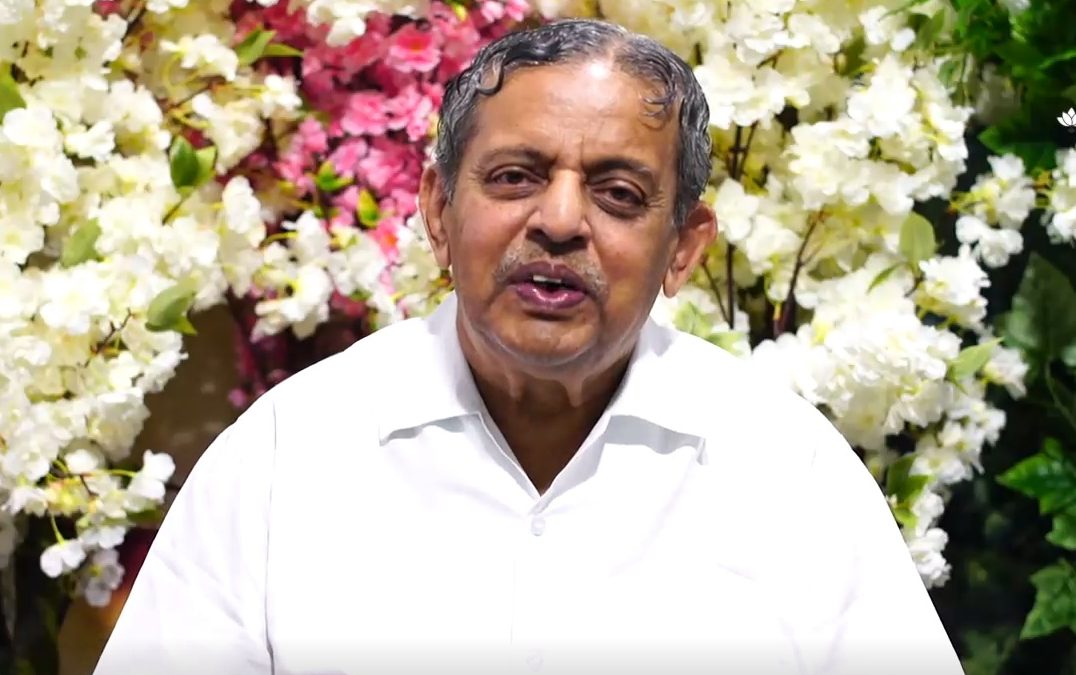Yoga Vidya Niketan (YVN), Member Institute of Indian Yoga Association successfully conducted its annual one-month Yoga Summer Course from May 1 to May 31, 2024. The course ran for one and a half hours daily across 41 physical centers around Mumbai and Navi Mumbai, extending…
Series on Patanjali Yoga Sutras
Patanjali Yoga Sutras with Guruji Dr. HR Nagendra, President, IYA
As promised, the Second series of Online Gurukulam- Learn with the Masters by Indian Yoga Association (IYA) took the viewers through elaborated journey of yoga with Guruji Dr HR Nagendra, President, IYA and Chancellor, Swami Vivekananda Anusandhana Samsthana (S-VYASA), Bengaluru on Patanjali Yoga Sutra. The series comprised of 4 sessions. In each session on every Sunday of November 2021, Guruji talked about in detail about 4 padas of Patanjali Yoga Sutra LIVE from 5pm-6pm on Facebook.
The aim of the series is to take the viewers in the journey of in-depth knowledge of different horizons of yoga making them further understand the importance of inculcating the ancient science into their lives.

IYA is a self-regulatory body of all Yoga organisations. Online Gurukulam is an endeavour to provide yoga lovers and followers of our vedic culture a chance to meet the world-renowned Yoga Gurus and learn from them free of cost. The Association aims at bridging the gap between the Guru and the disciple, and bring the wisdom of yoga in its purity and directly from the source.
Patanjali Yoga Sutras
Sage Patanjali wrote 196 sanskrit verses (aphorisms) to attain wisdom and for self-realization through yoga around 400 C.E. Considered as the basis of yoga philosophy, these sutras are distributed into four padas (chapters): Samadhi, Sadhana, Vibhuti, and Kaivalya. At the core, these sutras aim to help people explore, understand and implement yoga. These Sutras are one of contemporary yoga’s favourite sources of inspiration and guidance on how to live a balanced and ethical life both on and off the mat.
Webisode 9: Samadhi Pada
The first session which was held on November 7, 2021 focused on the first pada of the Yoga Sutras— Samadhi Pada. Samadhi Padas has 51 sutras and discusses the meaning of yoga and focuses mainly on themes of enlightenment, concentration, and meditation.
Guruji Dr HR Nagendra in his session went on to explain that the first point that Samadhi Pada emphasises on is ‘Atha Yoga Anushasanam’- Now is the discipline of yoga. Yoga is a discipline. Anushasanam can also mean that the discipline we have to follow for Yoga. Atha means next and it also means auspiciousness. Eligibility is the criteria and auspiciousness brought forth in the process and the discipline one has to follow has been condensed in this sutra.
A person with normal health and is able to grasp things, the one who is a seeker and wants to learn about Yoga, is free from stress and tension and is mentally, physically and emotionally fit the adapt and understand Yoga is eligible.
He then explains that unity with the Divine is only possible when one is able to separate mind from ego. Samadhi Pada allows you to understand that goal of concentration, as a means of achieving vairagya (detachment) through ahbyasa (practice). Obstacles to mental stillness are outlined in Samadhi Pada, followed by a description of the resulting state of absorption. This dissolving of the self is described as the key to ending mental pain and suffering.
This wonderful in-depth session on Samadhi Pada was followed by a session on Cyclic Meditation by Smt Gangotri Panda.
Webisode 10: Sadhana Pada
The second session by Guruji Dr HR Nagendra on November 14, 2021 focused on the second pada of the Yoga Sutras— Sadhana Pada.
Sadhana Pada talks about the means of achieving a yogic state with 55 sutras. In this pada, you are introduced to the eight limbs of yoga— Yama (Five principles of ethics), Niyama (Five principles of conduct & discipline), Asana (Physical practice of yoga), Pranayama (Breath regulation), Pratyahara (Sensory withdrawal), Dharana (Concentration), Dhyana (Meditation) and Samadhi (Self-realization). The seven Niyamas are followed to real Samadhi.
Guruji elucidated the concept of Kriya Yoga in this pada. Kriya meaning action and Kriya Yoga, the yoga of action, has three tiers, namely tapas, svadhyaya and Isvarapranidhana. Tapas means burning desire, Svadhyaya means self-study and Isvarapranidhana means surrender to God. When these three aspects of Kriya Yoga are followed with generosity, life’s sufferings are overcome and Samadhi is experienced.
To reach one’s goal, one her has to overcome five afflictions— Avidya (worldly or erroneous knowledge), Raga (desire and attachment), Asmita (ego), Dvesa (dislike) and Abhinivesah (fear of death). Pain and sorrow (duhkha) result from the affliction (klesha) of dislike (dvesha). The prime cause of afflictions is avidya or the failure to understand purusa and prakrti.
He then went on to explain the eightfold path of Yoga to achieve freedom for common man known as Astanga Yoga. Yamas are social moral conduct, Niyamas are to be followed strictly for self-development, Asana is a relaxed, steady and peaceful posture to make the physical body strong and ready for inward journey, Pranayama is the controlling of bio-energy. Combined together they are called Bahiranga Yoga and last three are called Antaranga Yoga.
The session concluded with a practical session on Mind Sound Resonance Technique by Smt Gangotri Panda ji.
Webisode 11: Vibhuti Pada
Vibhuti Pada consists of 56 sutras which talks about the benefits of practicing yoga regularly. Here you will deeply understand the final three limbs of yoga – Dhyana, Dharana and Samadhi. Guruji Dr HR Nagendra in his third session on Vibhuti Pada on November 21, 2021 talked about the art of integration (Samyama) through concentration, meditation and profound absorption in this pada.
Vibhuti Pada explains that one attains samadhi when you are able to let get rid of samskaras, klesha, karma, vasana, and conditioned belief systems that support the citta-vrtti. It begins with the concept of dharana (concentration), which is the sixth limb of Ashtanga Yoga. Dharana, dhyana (the seventh limb), and samadhi (the eighth limb) combined together is called Samyama, which is explained in detail in Vibhuti Pada.
Guruji in this session talked about the true nature of a Yogi who is devoid of artifice, falsehood, ignorance, and fantasy. He thereafter, talked about the significance of integrating the intelligence, ego and ‘I’ and importance of concentration, meditation and total absorption. With the help of Dharana, dhyana and Samadhi, intelligence, ego and ‘I’ principle are eventually sublimated. This may lead either to the liberation of various supernatural powers or to Self- Realization.
Vibhuti pada distinguishes, clearly and instantaneously, the difference between similar entities without analysing them according to the rank, creed, quality and place. The sadhaka’s intelligence and consciousness now rises to the higher level of the soul. All parts of the seer appear as the soul. This is kaivalya that comes when the powers, which attract the misguided, but distract the yogi’s consciousness, are renounced.
The session concluded with the practical session by Smt Gangotri Panda ji on Pranayama.
Webisode 12: Kaivalya Pada
Kaivalya Pada has 34 sutras that talk about liberation and freedom from suffering. Here, the text explores the ultimate goals of yoga and provides thoughtful insight on the unconditional, absolute liberation yoga provides.
In the first sutra of the Kaivalya Pada it is said that there are five ways by which perfection can be attained. Though the supreme method is yoga samadhi itself, known as samyama, there are other methods also. Guruji Dr HR Nagendra in his last session on Kaivalya Pada which was held on November 28, 2021 explained about mechanism and methods by which the people attain these five siddhis, fundamental laws of creation, laws build karma into our life like the law of action and reaction which are equal and opposite, in the physical world. He further explains about the good samskaras and bad ones which are built into our deeper layers of the memory, which continue to be with us births after births.
This is followed by the mechanisms of creation and destruction and their impressions, mental perceptions. The purusha is the real perceiver and the motivator. And the mind is the vehicle for perception. When the individual works on these things, he is able to attain moksha.
Janma auṣadhi mantra tapaḥ samādhijāḥ siddhayaḥ (Accomplishments may be attained through birth, the use of herbs, incantations, self-discipline or samadhi.)
Siddhis are perfections or attainments – achievements of powers. It is seen that certain created beings are born with certain perfections. This accompaniment of a perfection, or a siddhi, with one’s birth is due to previous practice.
It does not mean that a person gets powers at the time of birth by freak or by chance; it is a result of hard practice in earlier lives. Also, there are cases where certain powers are acquired by the use of medicinal herbs which are spoken about in the yoga scriptures. We have, in India especially, some Himalayan herbs known as Sanjivini, etc., which are supposed to enliven even a corpse. Other herbs create certain vibrations in the system and stimulate the nerves, and allow the concentration of the mind.
Austerity, or tapas, of an intense character may also generate powers. The subjugation of the senses, beyond a certain degree, will set up a corresponding reaction from within, and that reaction comes in the form of powers. Any form of self-control should bring powers; it is a natural consequence thereof.
The most prominent of all these is samyama, which is the subject of the Vibhuti Pada. That is also referred to here by the term ‘samadhi’. The communion of the individual with the object releases the total energy of the objects, and then it is that the meditating subject is invested with an enormous power which would have otherwise been completely isolated from it. The power of the world is outside us, and we seem to be little inhabitants of the world who cannot participate in the powers of nature. But by samyama, the powers of nature can be absorbed into our system.
The session ended with a practical session on Mind Sound Resonance Technique by Smt Gangotri Panda ji.
















